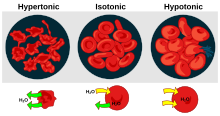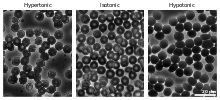Tonicity: Difference between revisions
Reverted 1 good faith edit by 71.207.203.8 using STiki |
|||
| Line 10: | Line 10: | ||
== Hypertonicity == |
== Hypertonicity == |
||
Hypertonic refers to a greater concentration. In biology, a hypertonic solution is one with a higher concentration of solutes on the outside of the cell. When a cell is immersed into a hypertonic solution, the tendency is for water to flow out of the cell in order to balance the concentration of the solutes. |
Hypertonic refers to a greater concentration. In biology, a hypertonic solution is one with a higher concentration of solutes than on the outside of the cell. When a cell is immersed into a hypertonic solution, the tendency is for water to flow out of the cell in order to balance the concentration of the solutes. |
||
When plant cells are in a hypertonic solution, the flexible [[cell membrane]] pulls away from the rigid [[cell wall]], but remains joined to the cell wall at points called [[plasmodesmata]]. The cell takes on the appearance of a [[pincushion]], and the plasmodesmata almost cease to function because they become constricted: a condition known as [[plasmolysis]]. In plant cells the terms isotonic, hypotonic and hypertonic cannot strictly be used accurately because the pressure exerted by the cell wall significantly affects the [[osmotic equilibrium point]]. |
When plant cells are in a hypertonic solution, the flexible [[cell membrane]] pulls away from the rigid [[cell wall]], but remains joined to the cell wall at points called [[plasmodesmata]]. The cell takes on the appearance of a [[pincushion]], and the plasmodesmata almost cease to function because they become constricted: a condition known as [[plasmolysis]]. In plant cells the terms isotonic, hypotonic and hypertonic cannot strictly be used accurately because the pressure exerted by the cell wall significantly affects the [[osmotic equilibrium point]]. |
||
Revision as of 12:57, 17 October 2013
This article needs additional citations for verification. (January 2012) |


Tonicity is a measure of the osmotic pressure gradient (as defined by the water potential of the two solutions) of two solutions separated by a semipermeable membrane. It is commonly used when describing the response of cells immersed in an external solution. Like osmotic pressure, tonicity is influenced only by solutes that cannot cross the membrane, as only these exert an osmotic pressure. Solutes able to freely cross the membrane do not affect tonicity because they will always be in equal concentrations on both sides of the membrane.
There are three classifications of tonicity that one solution can have relative to another. The three are hypertonic, hypotonic, and isotonic.[1]
Hypertonicity
Hypertonic refers to a greater concentration. In biology, a hypertonic solution is one with a higher concentration of solutes than on the outside of the cell. When a cell is immersed into a hypertonic solution, the tendency is for water to flow out of the cell in order to balance the concentration of the solutes.
When plant cells are in a hypertonic solution, the flexible cell membrane pulls away from the rigid cell wall, but remains joined to the cell wall at points called plasmodesmata. The cell takes on the appearance of a pincushion, and the plasmodesmata almost cease to function because they become constricted: a condition known as plasmolysis. In plant cells the terms isotonic, hypotonic and hypertonic cannot strictly be used accurately because the pressure exerted by the cell wall significantly affects the osmotic equilibrium point.
A hypertonic solution is used in osmotherapy to treat cerebral hemorrhage.[citation needed]
Hypotonicity
Hypotonic refers to a lesser concentration. A hypotonic solution has a lower concentration of solutes than its surroundings, so in an attempt to balance concentrations, water will rush into the cell, causing swelling. [2]
Some organisms have evolved intricate methods of circumventing hypotonicity. For example, saltwater is hypertonic to the fish that live in it. They need a large surface area in their gills in contact with seawater for gas exchange, thus they lose water osmotically to the sea from gill cells. They respond to the loss by drinking large amounts of saltwater, and actively excreting the excess salt. This process is called osmoregulation.
Isotonicity
An isotonic solution is one in which its effective osmole concentration is the same as the solute concentration of a cell. In this case the cell neither swells nor shrinks because there is no concentration gradient for water across the cell membrane. Water molecules diffuse through the plasma membrane in both directions, and as the rate of water diffusion is the same in each direction that cell will neither gain nor lose water. An iso-osmolar solution can be hypotonic if the solute is able to penetrate the cell membrane. For example an iso-osmolar urea solution is hypotonic to red blood cells causing their lysis. This is due to urea entering the cell down its concentration gradient follwed by water. For example, the osmolarity of Normal saline, 9 grams NaCl dissolved in water to a total volume of one litre, is a close approximation to the osmolarity of NaCl in blood, i.e. Normal saline is almost isotonic to blood plasma. Both sodium and chloride ions cannot freely pass through the plasma membrane as opposed to urea.
See also
References
- ^ Sperelakis, Nicholas (2011). Cell Physiology Source Book: Essentials of Membrane Biophysics. Academic Press. p. 288. ISBN 978-0-12-387738-3.
- ^ "Definition — hypotonic". The Free Dictionary. Retrieved 23 August 2012.
